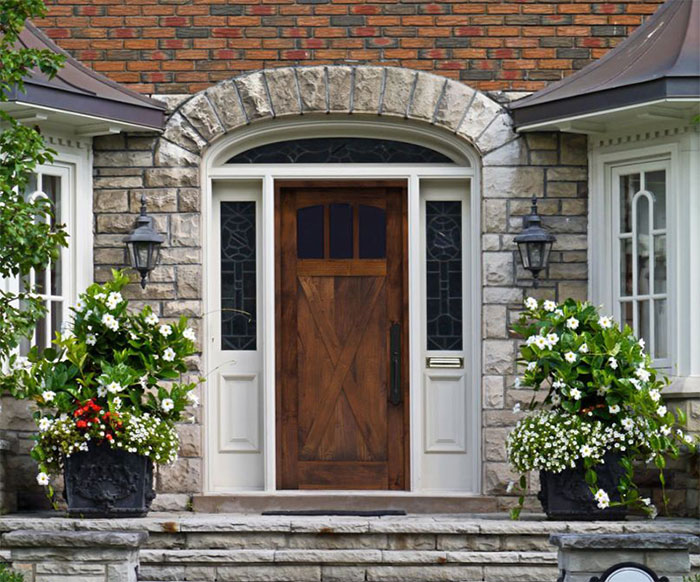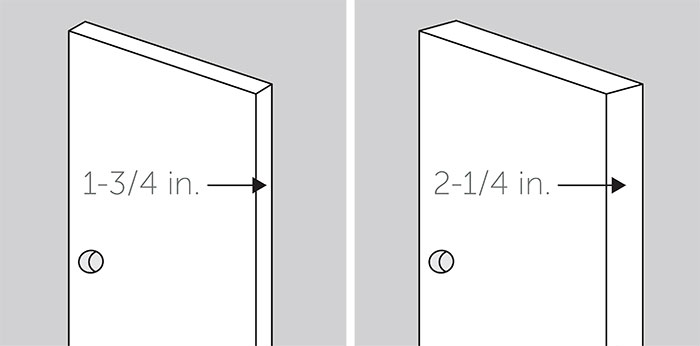800-891-8312
FREE SHIPPING* Most orders over $500 qualify. Free shipping applies to Barn Door Hardware, Barn Doors, and Pocket Doors over $500. Front doors, interior doors, shower doors, any oversized door (wider than 3ft and taller than 7ft) and any special order doors have shipping costs which are calculated at checkout. Some barn door hardware track lengths do not qualify for free shipping.

How To Measure For a New Front Door
Monday, June 10th, 2019
Share

Are you ready to replace your exterior door and jamb? Or are you ready to pick a door for new construction? Here are 10 simple steps to make sure you get an accurate measurement for your new door and jamb.
Getting an accurate measurement in 10 steps:
- Get the rough opening measurement.
Take the measurement of the width of your rough opening in three different places–one at the top of your opening (header), one in the middle, and one across the bottom. Hopefully those three measurements will be the same, but if not, take the smallest measurement. This will be the number you use when you specify the width of your new door and jamb.
Repeat this same process for the height of your opening. Again measuring in three different places along the height of the opening–one on each side, and one in the middle. Use the smallest number when you specify the height of your new door and jamb. - Get the depth of your door jamb.
Measure from the inside of the house to the exterior of your opening. To get an accurate measurement, measure from the finished surface of the interior wall of your house; typically the surface of your drywall. Measure to the exterior surface of the opening. If the exterior of your house is stucco, measure to the stucco. If your exterior has brick or some other surface, measure to the back side of the brick (where the brick attaches to the wall). This is the depth of your new door jamb. - Find the width and height of the slab (or door) that is needed.
The width of your door will be the measurement of the rough opening (figured in Step 1) minus 2-1/4". The height of your opening will be the measurement or your rough opening minus 3-5/16". (When measuring for an interior door, you do not need to take into account the threshold and so the height measurement will be the height of the rough opening minus 3"). - Identify your door thickness.
The standard thickness of most doors is 1-3/4". For exterior doors, another common option is 2-1/4". If your door is wider than 4 feet, then it needs to be 2-1/4" thick.
- Choose inswing or outswing.
This is an easy one. Do you want your door to swing into the house or out onto the porch. Most exterior doors swing into the house.
- Identify handing–left or right.
If you stand inside the doorway with your back to the hinges of the door, will your door swing open to the right or the left? If the door is to your right, it is a right hand swing, if your door is to your left, it is a left hand swing.
- Identify the distance from the bottom of your door to the middle of your handle.
For residential buildings, the standard height from the bottom of the door to the middle of the door handle is 36". For commercial buildings, this height is typically 41".
- Decide if you want a deadbolt on your door.
If you'd like a deadbolt on your door, you will need to order your door with a double bore. The industry standard for the second bore hole is 5 1/2" above the bore hole (center-to-center) for your handle. If you stick with this standard measurement, you'll have lots more options when ordering a door handle.
- Identify the backset for your handle.
The backset of your handle is the measurement from the outside surface of the edge of your door to the center of the bore hole for your handle. The most common measurements are 2-3/4" or 2-3/8". If you are going to use your current door handle on your new door, you'll need to know this measurement so the bore hole is the correct distance from the edge of your door. If you're ordering a new handle, you'll need to know this measurement when selecting your new handle.
- Identify your hardware function.
Choose whether you need a full handleset with a lever for knob and a deadbolt or if you just need a passage lever or knob. The most typical set up for a front door is a tubular entrance handleset. For this you would choose the finish of the hardware as well as the style of rosette (backplate) and the style of door knob and lever. The second most common front door hardware is a deadbolt on top of a knob or lever combination. Full mortise entry door hardware is an option as well as sidelock options.



Rustica Shop & HQ 1060 Spring Creek PlaceSpringville Utah 84663Customer Service & Sales(800)-891-8312

Hitching Post
Event Venue
1520 N Main Street
Springville UT 84663
PRODUCTS
FEATURES
COMPANY
BUSINESS



